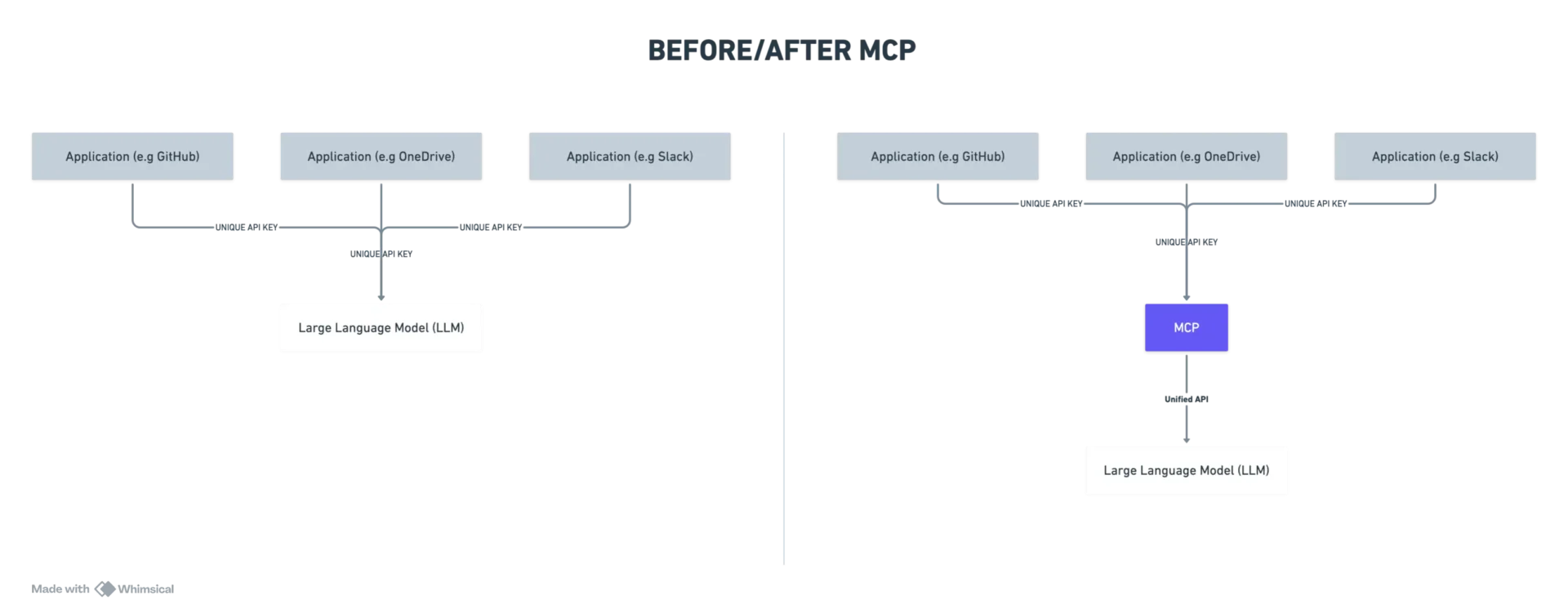The Model Context Protocol (MCP) is an open standard developed by Anthropic to facilitate seamless integration between AI models and external data sources. It provides a universal interface, allowing AI systems to access and interact with various data repositories without the need for custom integrations.
FalkorDB has implemented an MCP server, enabling AI models to query and interact with its graph database effectively. This integration supports advanced applications such as Graph Retrieval-Augmented Generation (GraphRAG), where understanding complex relationships within data is needed.

Highlights
- MCP abstracts tool integrations, letting AI systems query any supported source through a single interface.
- FalkorDB’s MCP server maps requests to Cypher, enabling GraphRAG with full schema and relationship context.
- Developers avoid brittle custom logic and gain query flexibility across identity, config, and structured sources.
Model Context Protocol (MCP)
MCP standardizes the way AI applications connect to external data sources. By defining a common protocol, it eliminates the need for bespoke connectors, streamlining the development process. This is particularly beneficial for applications requiring real-time data access and interaction.
FalkorDB’s MCP Server
FalkorDB’s MCP server acts as a bridge between AI models and its graph database. It translates MCP requests into FalkorDB-specific queries, allowing AI systems to retrieve and manipulate graph data efficiently. This setup is instrumental in applications where understanding the relationships between data points is essential.

Integrate FalkorDB's MCP server into your AI application
Step 1: Clone the repository
git clone https://github.com/falkordb/falkordb-mcpserver.git
cd falkordb-mcpserver
Step 2: Install dependencies
npm install
Step 3: Copy the example environment file and configure it
cp .env.example .env
Edit .env with your configuration details.
Addressing Common MCP Misconceptions
Misconception 1: MCP Is Just Another API
Clarification: MCP is not just an API; it’s a protocol that standardizes interactions between AI models and external tools or data sources. Unlike conventional APIs that require custom integration for each data source, MCP provides a unified interface, reducing development overhead.
Misconception 2: MCP Replaces All Existing Integrations
Clarification: MCP complements existing integrations by providing a standardized protocol. It doesn’t aim to replace all existing systems but rather to streamline the process of connecting AI models to various data sources.
Misconception 3: MCP Is Only for Large Enterprises
Clarification: While MCP is beneficial for large-scale applications, it is equally useful for smaller projects. Its standardized approach simplifies integration, making it accessible to organizations of all sizes.
Separating Hype from Reality
While MCP offers a standardized approach to integrating AI models with external data sources, it’s essential to recognize its current limitations. It simplifies integration and reduces development overhead but does not eliminate the need for thoughtful implementation, especially concerning security and error handling.
As Dhanji R. Prasanna, CTO at Block puts it:
“Open technologies like the Model Context Protocol are the bridges that connect AI to real-world applications, ensuring innovation is accessible, transparent, and rooted in collaboration.”

Limitations of MCP
- Authentication Handling: MCP does not define how authentication should be handled, leaving it to the implementation.
- Error Handling: MCP does not enforce a standardized error-handling framework, which can lead to inconsistencies across different implementations.
- Real-Time Updates: MCP does not natively support real-time updates or event-driven architectures, which may be necessary for certain applications.
Ideal Use Cases for MCP
- AI Assistants: Enabling AI models to access and interact with various data sources, such as calendars, emails, and documents.
- Enterprise Search: Allowing AI systems to search across multiple data repositories using a unified protocol.
- Automated Workflows: Facilitating the automation of tasks by enabling AI models to interact with different tools and services seamlessly.
- Graph Data Analysis: Integrating with graph databases like FalkorDB to analyze complex relationships within data.
What is MCP in AI integration?
When should I avoid MCP?
Build fast and accurate GenAI apps with GraphRAG SDK at scale
FalkorDB offers an accurate, multi-tenant RAG solution based on our low-latency, scalable graph database technology. It’s ideal for highly technical teams that handle complex, interconnected data in real-time, resulting in fewer hallucinations and more accurate responses from LLMs.



